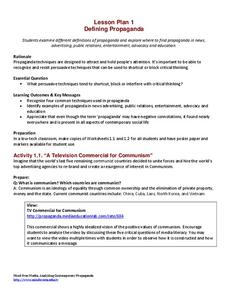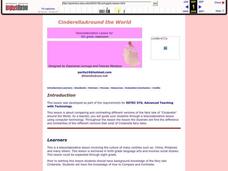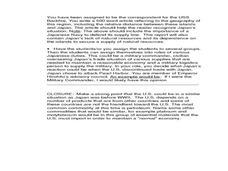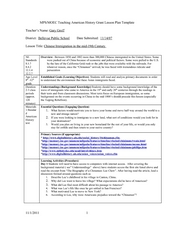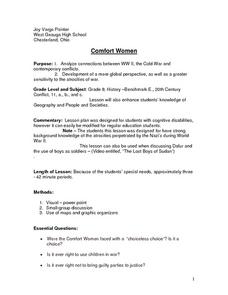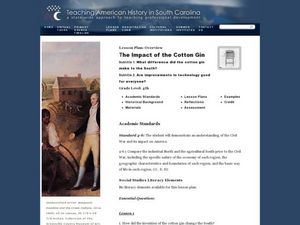Curated OER
Eu To End Its Oddest Policy
Students read, examine and critique a newspaper article on how the European Commission proposes to increase the amount of agricultural land under cultivation. They assess key vocabulary terms, the stress placed on pronunciation and...
Curated OER
Confucianism
Students examine the beliefs and history of the religion by studying mythology and sayings. They compare the beliefs of Confucian culture to American culture and share their information as class by an informal teacher lead discussion.
Curated OER
Asian Cinderella Tales
Explore the world of fairy tales using this lesson focusing on higher- order thinking skills. Learners compare and contrast an Asian Cinderella story to other versions. It is a great way to review the characteristics of the genre and...
Curated OER
Journey to Tibet
Students create "Culturegrams" from the library and travel guides provided during class. They use the library and PC lab during study hall to work on a PowerPoint presentation and show the PowerPoint to the class to describe your trip.
Media Education Lab
Defining Propaganda
21st century learners live in a media world. Help them develop the skills they need to be able to analyze the barrage of propaganda they face daily, with a resource that introduces them to the type of persuasive appeals found in...
Curated OER
Cinderella Around the World
Fourth graders compare and contrast different versions of the fairy tale of "Cinderella" around the World. They find the difference and similarities of the different versions that exist of Cinderella fairy tales.
Curated OER
Japan
Seventh graders identify some key concepts, ideas, and facts about Japan. Students identify shared traits and differences of Japan as compared to other asian countries. Students identify how geography can affect the culture of a place....
Curated OER
Taoism
Students identify and interpret Taoism. Students gain knowledge of various eastern philosophies. Students transfer knowledge gained using the higher order thinking skills for analysis. Students identify the key figure in Taoism....
Curated OER
Comparative Geography I
Students use population density and other statistics to compare countries. They find the population density for the countries listed in the table. Students compare findings with a partner, and then share with the class.
Curated OER
Immigration; The New Colossus
Seventh graders explore The New Colossus by Emma Lazarus. In this The New Colossus lesson, 7th graders read the poem and analyze its meaning. Students discuss what the poem means about American culture and why it was engraved on the...
Curated OER
How Do We Balance Environmental Conservation with Human Needs?
Students role play a meeting between conservation biologists and local representatives who want to advance the livelihood of local population. In this history lesson, students research the necessities and conservation issues of given...
Curated OER
Lee Chew's Story
Students put themselves in the shoes of a Chinese immigrant to America. In this immigration lesson, students read an account from Lee Chew, a Chinese immigrant to America in the 19th century. Students discuss their impression of the...
Curated OER
Imperialism in Africa
Learners study imperialism in Africa. In this Imperialism lesson, students consider how democratic revolutions around the world led to imperialism in Africa.
Curated OER
Pre-WWII Pacific W/Japan
Eleventh graders explain how the islands/countries contributed to Japan's war effort. They study the concept of location and determine how natural resources were a large factor in Japan's trade.
Curated OER
Chinese Immigration in the Mid-19th Century
Students interpret historical evidence presented in primary and secondary resources. In this Chinese immigration lesson plan, students research the Chinese immigration between 1850 and 1882.
Curated OER
Korean Lesson Plan
Seventh graders are introduced to the history of Korea. Using maps, they identify the reasons why Korea is important geographically. They also research the reasons for the Korean War and how actions of the United States and Korea led...
Curated OER
Map Work About the Korean War
Students use an interactive website that chronicles the occupation of the Korean peninsula by each year and complete a worksheet. This helps them to research the causes of the Korean War.
Curated OER
Ancient Man in Asia
Seventh graders analyze and synthesize information about major historical developments by interpreting data, evaluation sources of information, identifying and comparing experiences and perspectives from multiple cultural perspectives.
Curated OER
Democratic Revolutions
Students study the Age of Revolutions. In this Latin America lesson, students consider how democratic revolutions around the world led to imperialism in Latin America.
Curated OER
Using Charts and Graphs to Study East Asia's Modern Economy
Young scholars examine East Asia's modern economy. In groups, classmates use the internet to compare the resources, products, and economy of specified countries. After collecting the data, pupils create charts, tables and graphs. They...
Curated OER
Chinese, Japanese, and Korean Language Basics
Students in seventh and eighth grade Introduction to Foreign Language class are introduced the basic greetings, farewells, courtesy words, and basic phrases in Mandarin Chinese, Japanese and Korean. In pairs, they create a very short...
Curated OER
Chinese, Japanese and Korean Numbers and Luck!
Learners explore numbers in Mandarin Chinese, Japanese, and Korean. They discuss numbers and practice writing and speaking numbers 1-10 in Chinese, Japanese, and Korean. As they create a chart of the three countries' numbers, they...
Curated OER
Comfort Women
Ninth graders analyze connections between WW II, the Cold War and contemporary conflicts. They discover a more global perspective, as well as a greater sensitivity to the atrocities of war, and how the atrocities against the...
Curated OER
The Impact of the Cotton Gin
Fourth graders study Eli Whitney and the cotton gin. In this lesson on the cotton gin, 4th graders use primary and secondary sources to gather information about Eli Whitney, the cotton gin that he invented and how it changed the south.






